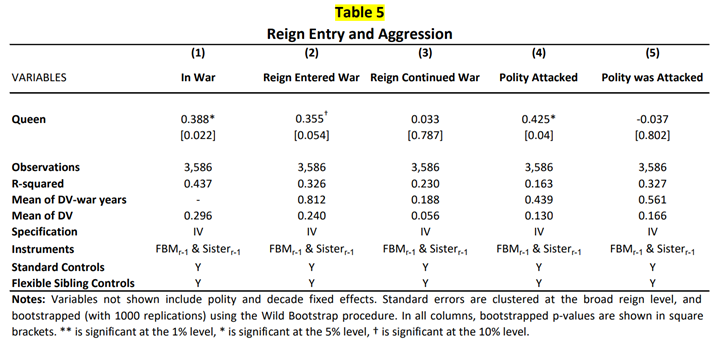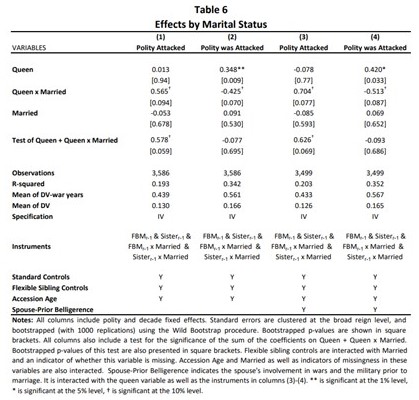In an interview with German media following the G7 summit in June 2022, then unresigned Prime Minister Boris Johnson said,
“If Putin was a woman, which he obviously isn’t, if he were, I really don’t think he would have embarked on a crazy, macho war of invasion and violence in the way that he has. If you want a perfect example of toxic masculinity, it’s what he is doing in Ukraine.”
Such gynocentric delusion, and not confined to Johnson, was both predictable and predicted. Over three months earlier the blog Toxic Feminism had predicted it and got the refutation of it in first. In the days of absolute Monarchs (or other tyrants when the controlling hand was clear) it has been claimed previously that queens were more likely to wage war than kings. Following Johnson’s typically ill-informed comment, Edward Bartlett has produced another refutation, citing an even longer list of female war leaders as counter-examples.
You can undoubtedly think of further examples. Eleanor of Aquitaine is the obvious one. Though never formally Monarch in her own right, as the Queen of France and then Queen of England, Eleanor enjoyed monarchical influence and power in her own right. She was also one of the most scheming women in history and instrumental in the second crusade, rather a notable armed conflict.
In more recent UK history, the majority of female MPs in 2003 voted in favour of the UK joining the Iraq war (83 out of the 104 women who voted, a larger proportion of women MPs in favour of the war than male MPs). A majority of female MPs also voted in favour of bombing Syria (98 women in favour, 83 against). Perhaps what would deter women in power from waging war would be vast numbers of female deaths in war. But war deaths are still overwhelmingly a male privilege. In the campaign that followed the invasion of Iraq on 20 March 2003 and came to an end in April 2009, the UK war deaths were 173 men and 6 women (3% women). In the 14 years starting in October 2001, the number of UK war deaths in Afghanistan were 453 men and 3 women (0.7% women). In contrast, around 12% of UK armed services personnel are now women (over 20% in the RAF).
However, what none of these observations or articles do is address the statistical question: is there a tendency for female leaders to result in a reduced likelihood of the nation in question being involved in armed conflict? The statistical analysis has been done and published as Queens by Oeindrila Dube and S.P. Harish (2019).
Dube and Harish note that several published works addressing this question in the modern era are “difficult to interpret since women may gain electoral support and come to power disproportionately during periods of peace”. Consequently, the analysis of Dube and Harish focusses on European states in the period 1480 to 1913 and upon polities that had at least one female ruler over this time. The other advantage of confining attention to this earlier epoch is that absolute Monarchs were the norm – or, at least, highly influential Monarchs. In Parliamentary systems, power became more diffuse, and hence the war-like tendencies of individuals less apparent.
Dube and Harish constructed a dataset of conflict participation in 18 European polities across 193 reigns during every year between 1480 to 1913. Queens were the ruling Monarch in 18% of these reigns. (That, incidentally, shows how false is the popular narrative that women had no political power before the last few decades). It is rather a thorough piece of statistical analysis, controlling for many variables and with a variety of dependent (predicted) variables.
One issue Dube and Harish address is the concern that the conditions which bring a woman to power, e.g., the lack of a male heir, may themselves promote armed conflict – so that a correlation of war with female leaders may not be causal. The authors therefore control for such a lack of a male heir, and also for the existence of a sister of the previous Monarch (which also increases the chance of female succession). They also demonstrated that their results were insensitive to dropping any one queen, or any two queens, or to dropping entire polities. They carried out a range of sophisticated statistical tests which (without having delved too deeply into the details) would seem to give their results some solidity.
They found that “polities ruled by queens were 39 percentage points more likely to engage in a war in a given year, compared to polities ruled by kings”.
Their Table 5, reproduced below, indicates that this result is statistically significant “at the 5% level” (by which they mean at the 95% confidence level, the p value being 0.022).
One possible reaction to this finding might be to claim that states led by a woman might be seen as easy targets by aggressive neighbours, and hence be more prone to being attacked. If so, it would not be the female leader’s choice to engage in war. Dube and Harish examined this explanation by disaggregating according to which side was the aggressor. The result shows an interesting dependence upon whether the Queen in question was married. Quote,
“We find that among married monarchs, queens were more likely than kings to fight as aggressors. Among unmarried monarchs, queens were more likely than kings to fight in wars in which their polity was attacked.”
To paraphrase, unmarried female leaders would indeed seem to have been perceived as soft targets. But, in contrast, married ruling Queens were especially aggressive and more likely than Kings to start conflicts themselves – perhaps, one might guess, because they enjoyed a closer link with their armed forces through the agency of their husbands (which in no way diminishes the Queens’ own agency in the decision to go to war). Overall, it was found that the Queens’ own aggression was the dominant feature in terms of the state being engaged in armed conflict. Referring to their fitted model, Dube and Harish write,
“The coefficients indicate that the queen effect on war participation (.388) stems disproportionately from participation in wars in which the polity attacked (.425) rather than in wars in which the polity was attacked (-.037). These results suggest that queens did not end up engaged in war solely because they were attacked, and that the perceived weakness idea alone cannot account for the effects.”
I reproduce their Table 5 below so you can see where these data come from.
Similarly, their Table 6, also reproduced below, shows how disaggregating by the Queens’ marital status reveals that it is married Queen’s that are especially aggressive, whereas unmarried Queens tended to be aggressed against. Table 6 shows that married Queens were 56% more likely to initiate war, even if their spouses had no particular prior belligerence.


There are examples of female totalitarians. today. Maxine Waters demanding the harassment of political opponents. Grethcen “Stalin” Whitmer trying to stamp out any political dissent. AOC advocating the harassment of political opponents and the silencing of anyone who disagrees with her.
The View – a female only show – often advocates the silencing of any dissent.
Women are tyrants to the same degree as men.
There is the notorious feminine dynamic at the interpersonal level of “let’s you and him fight”.
This contrasts with men’s practical personal experience of when to escalate, and more crucially how to de-escalate conflicts that could turn violent.
Perfectly possible that the personal experience of princely heirs apparent may differ from the more general experience, of course.
The Fat (ex)Controller will say anything that he thinks is expedient – witness his recent pro-alphabet people remarks in flagrant disregard of our nation’s Christian tradition.
Talking of Toxic Masculinity, I’ve seen surprisingly little reaction to the current blatantly sexist EE advertising campaign involving hatchet-faced female footy players, which IMO is far worse than Gillette’s was. Or are we so inured now to this kind of thing that we pass by on the other side?